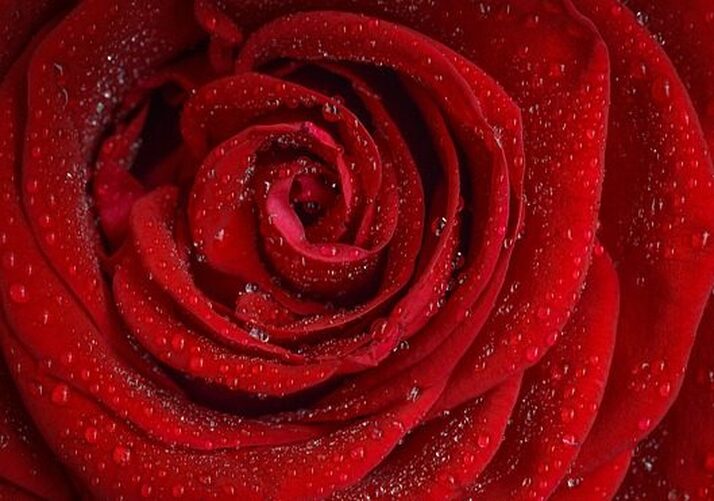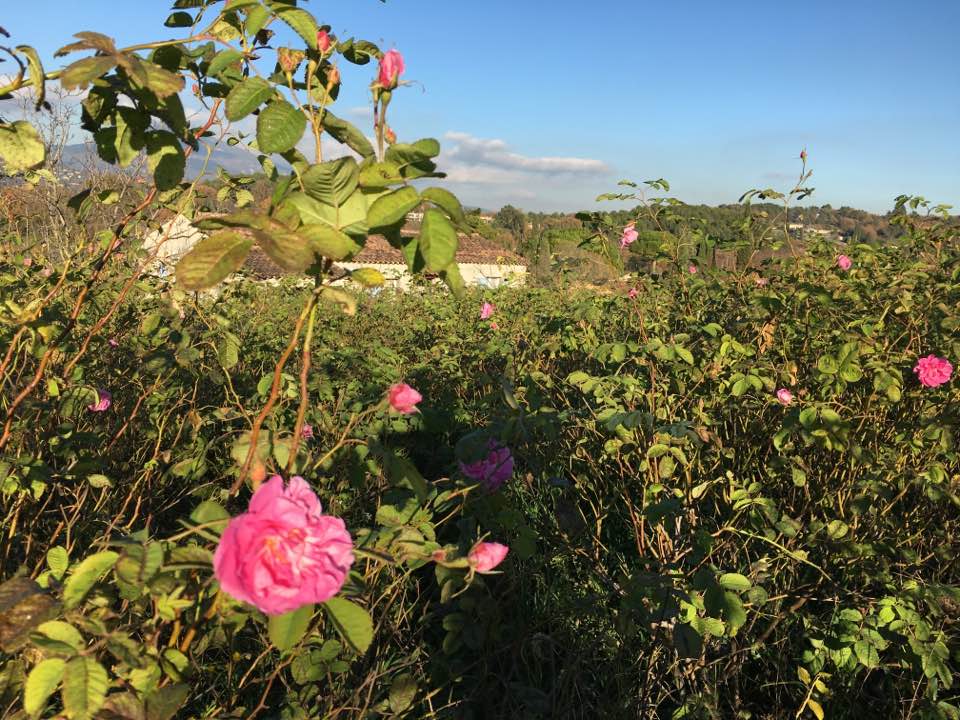Just as with its multi-faceted scent, the rose is more than one colour, and neither is it particularly European. Traces of rose wreaths have been found in ancient Egyptian tombs. Unlike stone or metal dried plants life rarely survives time and the origin of rose usage is rare before the Classical period. The oldest painting of a rose was found in a wall fresco from the Minoan civilisation in Knossos created between 1900 and 1700 BCE. Traces of the original colours can be seen both a yellow tinge and a pink.
The classical mythology of Europe relates the story of the goddess Aphrodite and Adonis. Aphrodite was the goddess of love, lust, beauty, pleasure, passion and fertility. She was an immortal, one of the Olympian gods. The origins of her worship preceded her Greek myth, for she was the Phoenician Ishtar, whose cult was based on the Sumerian cult of Inanna, Queen of heaven.
Aphrodite’s symbol became the red rose after her mortal lover Adonis, was gored in the groin by a wild boar so symbolising his loss of masculinity and his life. Aphrodite ran to her lover but too late to save him for tripping upon a rose runner she pricked her foot on the thorns of a white rose and stained the flower with her blood; whereupon the rose turned red. The red rose became the symbol of passionate love.
Classical Greece was very well acquainted with the rose so clearly the rose with its fragrant uses must have predated the classical period. In the Iliad the story is told of Hector after his death at the hands of Achilles was anointed with rose oil. At the time only maceration of rose petals were known so many tons of roses had to be produced to make an effective rose scented oil. This implies a large agricultural industry.
According to the same Iliad Aphrodite washed her skin with rose oil by day and night! Rose cultivation must have been in vogue for the Greek historian Herodotus records King Midas of Phrygia having a cultivated rose of sixty petals. It was Sappho the Greek poetess writing in Lesbos in the 7th century BCE who termed the Rose ‘Queen of Flowers’ writing, ‘The rose each ravished sense beguiles’. It was the Romans however that could be called mad about the rose.
In ancient Rome roses were everywhere and so to support this demand Rose growing had to be extensive. Rose unguents and cosmetics were common, rose filled pillows, wreaths for all manner of occasions, raining rose petals upon guests, and Mark Antony’s fleet had its sails scented with rose water. Extravagance was the moment the emperor Nero spent over a one hundred and fifty thousand euro to cover the beach at Baiae near Naples.
As perfumers we might take notice of the varieties chosen and the places where the roses were grown and cultivated. We would look to modern Palestrina southeast of Rome and the Nile Delta as well as in North Africa modern Algeria and Morocco. What remains a mystery is how the rose petals coming by sea from North Africa, is how the flowers apparently remained fresh and unspoiled.
The most likely species of rose eventually providing the cultivars of the Greeks and Romans is from the wild Rosa Gallica. Once the Dark ages descended upon Europe it was not until the Crusaders returned that the finer things of life caught hold again. Thibault the IV, Count of Champagne and troubadour returned with the rose variety Gallica ‘officinalis’ that has given us the Gallica roses even providing rose varieties today. It was notable for its scent.
The town of Provins once the capital of the Counts of Champagne became the centre of the rose petal industry. Midsummer flowering these are the large, flattish double flowered roses loved by the Empress Josephine at Malmaison where 160 varieties were known.
If the crusade reinvigorated the interest in the beauty and the scent of roses it was from Persia that much of the rose romance originates. Persian carpets, paintings and poetry are suffused with roses. We should well remember that Avicenna the famed physician is described as the father of aromatherapy. Certainly the art of distillation was known and used to produce the famous rose water. As Islam took hold in Persian society the symbolism of the rose was maintained in the Muslim religion. The famous poet Omar Khayyám was reputed to have rose growing on his grave from which seed was collected and cultivated in the famous London Kew gardens and is still grown today.
This Persian rose we are now talking about Rosa damascene, the Damask rose or sometimes as Bulgarian rose or Turkish rose. The damascene is highly fragrant and was cultivated in mists of time. Unlike Gallica which has a single flowering period damascene has a secondary type called semperflorens which has a longer flowering period. Iran, Bulgaria and Turkey are the most prolific producers of rose oil from the different cultivars of Rosa × damascene.
The rose variety Kazanlik, grown in Bulgaria in the Rose Valley region, produces the finest distilled otto or pure rose oil. Under the Ottoman Empire, and especially from the 19th century Bulgaria has become the world leader in manufacturing rose otto. Whilst the emphasis might be upon the scent rose has a long history as an apothecary standby as an anti-inflammatory and antioxidant which makes it ideal for skincare benefits.
Modern genetics suggest that this prolific scented Damask rose has R.Gallica in its parentage combined with Rosa Moschata the Musk rose. The musk rose’s origins are a mystery. It has never been found in a truly natural state. Whilst R.Damascena is collected in early morning when its scent is best the Musk rose scent travels far and is most potent at dusk. The fragrance is not found in its petals but its stamens. In his work ‘Of Gardens’, the English philosopher Francis Bacon declared the musk rose second only to violets in yielding ‘the sweetest smell in the air’.
There are five classic roses that make up what is known as the eldest group of cultivated roses. They are Gallica, Damask, Alba, Centifolia, and Musks. R. Alba maintains the sweetness of aroma expected by these older roses and it became famous for its choice as the White Rose of the House of York during the English wars of the Roses for the English crown succession. The house of Lancaster sported the red rose., the R.Gallica officinalis.
Sometimes because the town of Provins sounds like the region of Provence the two names are confused. The Provence rose, is Rosa Centifolia, meaning the rose with a hundred petals. This rose is also known as the cabbage rose or Rose de Mai and familiar as the source of many rose absolutes. Its parentage includes R.Damascena hence the fragrance.
If we guess that R.Moschata originated on the eastern end of the Himalayas we can look further east to China. China has its own set of cultivars and as we are discovering with roses their origins are obscure, not fully known. Roses as we would understand them, are not pictured in China before the tenth century unlike the Chrysanthemum which is seen from earliest times. Roses do not feature in Chinese mythology and have no great prominence in herbals although cultivated for some centuries.
In Europe it appears that roses were mostly grown for their petals or as extracts in the form of maceration, distillations and waters. Fragrance and perfume then were the most prominent or desirable features. Whilst roses were in themselves beautiful, they were not cultivated in the same way as today which now emphasises colour and flower shape as most significant. This change came with the introduction of what came to be known as China roses.
China was a closed country to Europeans for many years. The Portuguese were the first to establish a trading post in Macao and later came the English East India Company who established a monopoly of trade from Macao and Canton. Foreigners were restricted from entering inland so no great plant hunters or botanical expeditions took place before 1870. Instead, a few different roses trickled through, mostly small flowered with little or no scent but with a perpetual flowering time. By the 19th century four stud types of China roses had been established including yellow rose and those with a scent of tea.
In the modern world Hybrid Tea roses are the biggest and most popular group of roses commercially sold. As noted above shape or form colour and texture has taken over as pride of place in choice. Scent is secondary and not outstanding as with the older varieties. The question we could ask is what does a rose smell like?
There is no distinct rose smell. Rose not only has a variety of cultivars and species but also the same gamut of smells. Many odours can be found like the smell of green tea, honey, lemon or citrus, moss, fruit, or like other flower species such as violets, or clover even hay. The smell that majority of people associate with roses belongs to the Damask rose, R.Damascena, thought to be by some the most fragrant of rose species. The smell of the Damask rose is recognised as the standard in the fragrance industry for real or pure rose otto.
There are many variations in the smell of absolutes and an absolute from perfumery raw material suppliers such as Firmenich may not necessarily correspond to say that of IFF or Albert Vieille. There are many great names that supply excellent natural rose extracts and essences. Unfortunately the main constituents such as phenylethyl alcohol, citronellol and geraniol are easily replicated and due to cost of the original natural sources most rose fragrances are synthetic.
One now famous rose grower in the UK, David Austin bred the English Rose. As French growers since the time of Malmaison had maintained their traditional fragrant heritage the market had moved to the world of Hybrid Teas. David Austin began some now 60 years ago to reverse this trend. The most famous rose for fragrance from this grower is called Gertrude Jekyll and now small lots of this rose are on offer as either otto or macerates. If a gardener, the choice is now over 200 varieties with a highly fragranced selection of over seventy which can be distilled for their fragrance with their subtle differences.
It is a joy to see that artisan distillers and producers are beginning to turn to these small batch productions which can provide the natural perfumer with a new source of inspirations and ideas. Instead of the traditional fields of pink Kazanlik variety it is also a visual joy now to see the colours of white, cream, cerise, yellow, peach and red contributing the sensory experience of the Queen of Heaven, the mystic rose.


 RSS Feed
RSS Feed